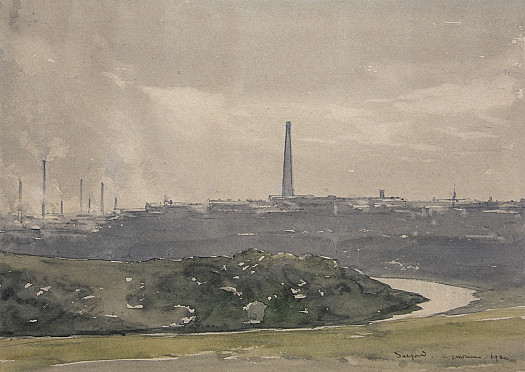Charles Holmes was born in Preston, Lancashire, on 11 November 1868, the elder son of the Rev Charles Rivington Holmes, vicar of St Michael’s Church, Bromley-by-Bow, and his wife, Mary (née Dickson), the daughter of a Preston solicitor. He was the nephew of Sir Richard Rivington Holmes, the artist, curator, archaeologist and librarian at Windsor Castle. He was educated at St Edmund’s School, Canterbury, and then, from 1883, at Eton College. In 1887, he won a Classical Scholarship to Brasenose College, Oxford.
Mainly self-taught as an artist, Holmes produced the first of his industrial scenes in 1889.
In the same year, he settled in London, and began a career in publishing. He worked with his cousin, Francis Rivington; at the Ballantyne Press; with John Cumming Nimmo; and finally, between 1896 and 1903, managing the Vale Press with the artists, Charles Ricketts and Charles Shannon. Ricketts fostered his talents for drawing and painting, while William Strang encouraged him to learn to etch. During the 1890s, he executed more than 80 plates. In 1900, he began to exhibit at the New English Art Club. (His address at the time was 22 Markham Square, Chelsea.)
At the prompting of the poet and art historian, Laurence Binyon, Holmes contributed an article on the Japanese printmaker, Hiroshige, in September 1897, to the periodical, The Dome. Two years later, he published his first book on another Japanese artist, Hokusai. Soon, he was sharing the task of writing art criticism for The Athenaeum with Roger Fry. His first major book was Constable and his Influence on Landscape Painting (1902).
In 1903, Holmes married his cousin, the composer and violinist, Florence Mary Hill Rivington. Initially, they lived at 58 Kensington Park Road, moving to 73 Ladbroke Grove in 1907. They would have two sons. It was also in 1903 that Homes was approached by Roger Fry to support The Burlington Magazine, which had recently been founded. So he became the co-editor with Robert Dell (a position he retained until 1909). A year later, in 1904, he was appointed Slade Professor of Fine Art at Oxford and elected to the New English Art Club. In 1909, he held his first solo show at the Carfax Gallery, in London. His Slade lectures formed the basis of Notes on the Science of Picture-Making (1909) and Notes on the Art of Rembrandt (1911). As both artist and writer, he was well placed to write the catalogue for the ground-breaking exhibition, ‘Manet and the Post-Impressionists’, which was organised by Fry and held at the Grafton Galleries in 1910.
In 1909, Holmes became Director of the National Portrait Gallery (resigning from The Burlington Magazine and, a year later, the Slade Professorship in order to dedicate himself to its demands). He rehung the collection and initiated a national photographic record. For a year of the First World War, from 1914-15, he served in the Anti-Aircraft Corps of the Royal Naval Volunteer Reserve. (By then, he was living at 1 Pembridge Crescent, Notting Hill.)
In 1916, Holmes moved, somewhat reluctantly, to the National Gallery to take up its Directorship. Within the constraints of working with a board of amateurs, he achieved much to increase the public’s understanding of the collection. He organised the photographic and publishing departments, and raised the standard of museum publications, most notably with the Illustrated Guide to the National Gallery (1921) and three catalogues of the various national schools of art (1923-27). Again, as a practising artist, he was able to contribute first-hand insights to discussions of technique and approach. He was knighted in 1921 and appointed KCVO in 1928, the year in which he retired from the National Gallery.
Holmes’s own work as a painter was the subject of books by Michael Sadleir (1920) and his friend and collaborator, C H Collins Baker (1924). He was elected an associate of the Royal Society of Painters in Water-Colours in 1924 and a full member in 1929, and served for a while as its Vice President.
Holmes’s final publication was the autobiographical Self and Partners (Mostly Self), published in 1936. He died at his home, 19 Pembridge Gardens, late the same year, on 7 December 1936.
His work is represented in numerous public collections, including the British Museum, Tate and the V&A; the Ashmolean Museum (Oxford), the Harris Museum & Art Gallery (Preston), Manchester Art Gallery and Samlesbury Hall (Blackburn); Aberdeen Art Gallery; and the National Gallery of Victoria (Melbourne).
Further reading:
C H C Baker, rev Mark Pottle, ‘Holmes, Sir Charles John (1868-1936)’, H C G Matthew and Brian Harrison (eds), Oxford Dictionary of National Biography, Oxford University Press, 2004, https://doi.org/10.1093/ref:odnb/33953;
Lee Sorensen (ed), ‘Holmes, C J, Sir’, Dictionary of Art Historians, https://arthistorians.info/holmesc


